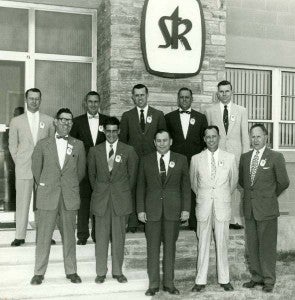Remembering: The St. Regis Paper Company
Published 11:55 am Saturday, June 7, 2014
Clyde Parker
CONTRIBUTING WRITER
FRANKLIN—As we drive down Armory Drive, we are seeing the last vestiges of what was for decades a significant part of the Franklin Southampton economy — St. Regis Paper Company and its successors. As of this writing, the once massive and, in its day, state of the art manufacturing facility is practically gone.
Actually, St. Regis, a major producer of industrial multi-wall paper bags out of the Franklin plant, ceased operations on that site in 1983 when the Franklin facility was purchased by Champion Paper. Not too long after that, the company was sold to Stone Container, which operated the plant for a while but ceased operations on that site in 1986, at which time the property was bought by Nansemond Cold Storage of Suffolk. Since that time, the building has been used for multiple purposes including use as a storage facility and for the production of plastic trash containers (American Plastics Inc.).

In 1955 at the grand opening. Front row, from left, Bill Harris; Jimmy Surace, plant manager; Jutt Sanford; Curtis Rhodes; and Bill Ludt; back row, from left, George Hedgepeth, personnel manager; Perk Brett, Henry Duck, Shorty Lowe and Jim Curling. — SUBMITTED | GEORGE HEDGEPETH
In 1997, David DiPaolo of Norfolk purchased the property. He used the building as the North American distribution center for “Herman Survivor” shoes, which were manufactured in Poland at a facility owned by DiPaolo’s family.
DiPaolo is the owner of the Armory Drive property. He has named it “1101 Armory Drive.”
Even though there have been various owners of the property over the years, with a lot of different names and logos, many people within the community have continued to call it the old St. Regis property.
In recent times, it became very difficult to maintain the aging structure. Most recently, vandals were doing their handiwork and much of the building’s infrastructure was ransacked and/or stolen.
“A series of burglaries over the past three months prompted my decision to demolish the building. In addition to vandalism, there have been thefts of internal workings such as copper wiring. This has totaled about $750,000. It’s to the point where it is unsafe and not worth keeping,” DiPaolo said.

In the finishing department is George “Top” Hedgepeth when he was first hired in 1946 at Taggart. — SUBMITTED | GEORGE HEDGEPETH
Handling the demolition are Crowder & White Contracting and Mason Restoration.
A sign is up on the property to show it is for sale or lease and that it can be sub-divided or built to suit. “I think it’s going to be much more attractive,” added DiPaolo. “It’s the last piece of usable property on Armory Drive. They call that ‘The Golden Mile’ for a reason. It’s a beautiful piece of property.”
Franklin City Manager Randy Martin said, “This is a prime attractive property and excellent location.”
Amanda Jarratt, president and CEO of Franklin/Southampton Economic Inc., said, “We think it’s a prime area on Armory Drive and has great potential for future commercial development.”
As you read this, the building is rumble, and the ground on which it stood will soon be flat.
Looking ahead, it is anticipated that the property is and will be a prime piece of commercial real estate, just perfect for marketing. It is near a major Franklin intersection, Armory Drive, which has been extensively developed over the last several years, and South and North College Drive; it is in close proximity to U. S. Routes 58 and 258; and it has rail siding connecting it to CSX Railroad.
Looking back, all of the preceding is in considerable contrast to the celebration that followed when The Tidewater News, for Thursday, March 11, 1954, hit the streets of Franklin. “NEW PLANT FOR ST. REGIS” was the headline.
You see, an earlier decision was made for St. Regis Paper Co. to relocate out of the area when a contract that existed between Camp Manufacturing Co. and St. Regis was scheduled to expire on March 31, 1954.
At that time, the location for the St. Regis plant was on Camp Manufacturing Co. property in Isle of Wight County, just behind No. 3 paper machine where rolls of kraft (unbleached) paper coming off that machine were transported from its ramp by way of a conveyer system directly into the St. Regis building. That is where the paper was converted into multi-wall paper bags. The finished and printed bags were used in the animal feed, fertilizer and chemical industries.
Sinclair and Valentine, another Franklin company which existed at that time, provided the inks that were used by St. Regis in their printing process.
The contract was for Camp to sell kraft paper, and lease space, to St. Regis for the purpose of producing multi-wall paper bags. Camp Manufacturing Co. was not going to renew the contract because they (the mill) needed the space being occupied by St. Regis. Camp was transitioning to a wider range of paper grades. It became necessary for the paper mill to be organized and set-up accordingly.
So, St. Regis announced that they would relocate outside the Franklin area and use paper produced at their own mills.
On Tuesday, though, a telephone call from an official at St. Regis Paper Co. in New York to the Editor of The Tidewater News in Franklin brought good news. St. Regis reversed itself. They will remain.
The Tidewater News was given the exclusive break on the biggest news story in years, at that time, for the people of the entire Franklin area. St. Regis will remain. But, it would not be at its present location — on the Camp Mill site. It would not even be in Isle of Wight County. In fact, a new plant, with expanded capacity, was to be built just outside the town limits of Franklin in Southampton County.
The St. Regis announcement indicated that they had selected a 21-acre site, on the back part of the Paul D. Camp farm, then owned by Camp daughters Ruth Camp Campbell of Franklin and Mrs. Charles R. Younts (Willie Camp Younts) of Atlanta. The site was located southwest of Franklin, at that time, approximately 1,000 feet outside the town limits, adjacent to the Seaboard Air Line Railroad (now CSX). That is where St. Regis would build and occupy their new bag plant. At that time, the entire area beyond the site to the southwest was woodlands and marshy areas.
Initially, access to the plant was by way of Andrews Street (now South College Drive), which connected from South Street. Later, Gardner Street was extended. At that time, it ran directly in front of the St. Regis property. And, this was as far as it went. Back then, it was a dead-end street at that point. And, at that point, later, in the early 1960s, Route 671, the new highway from Franklin to Boykins, was to be built, which, of course, eventually led to the establishment and retail development of Armory Drive.
And, at that time, North College Drive did not exist.
Construction of the new facility began in June of 1954 and was completed in the spring of 1955. Operations continued at the old plant until the new plant was ready for occupancy. Occupying more than 160 thousand square feet of floor space, more than twice as much as was available in the old plant, the new plant was to provide facilities for four tuber lines, printing and engraving, paper and bag storage and general offices.
Unusual for the time, is the fact that the manufacturing floor, where the bag converting machinery was located, was air conditioned. There were two 450 ton air conditioning units. The paper roll storage warehouse was under humidity control. It was important to maintain certain levels of moisture content in the paper.
When operations started up at the new site, St. Regis discontinued using Camp Manufacturing Co. paper. From then on, St. Regis, for the most part, started using paper manufactured in their own kraft mills. The exception was when Camp Manufacturing started producing asphalt laminated paper; and this was done exclusively for St. Regis. This type of paper was not available anywhere else. For certain types of bag end uses, this was a very desirable type of paper.
Here, we provide more history to the “St. Regis in Franklin Story.” Actually, starting in October of 1941, a company named Taggert Manufacturing Co., a Maryland corporation, not St. Regis, occupied the space at the paper mill. This was several years after Camp Manufacturing Co. affiliated with Chesapeake Corporation of Virginia out of West Point for the purpose of manufacturing paper at the Franklin mill. This was a joint venture and the name of the combined companies became Chesapeake-Camp Corp. Chesapeake-Camp negotiated a contract with Taggart. Essentially, the terms of the contract called for Chesapeake-Camp to erect a manufacturing building in accordance with specifications provided by Taggart. And Taggart would use paper manufactured by Chesapeake-Camp to produce multi-wall paper bags.
For the record, in 1946 the paper-making agreement between Chesapeake Corporation of Virginia at West Point and Camp Manufacturing Company, headquartered in Franklin was dissolved; therefore, Chesapeake-Camp Corporation, too, was dissolved. The name Camp Manufacturing Company came back into existence; and previous agreements reached between Chesapeake-Camp Corp. and Taggart remained in effect.
In the mid-1940s St. Regis bought Taggart, at which time the Taggart name disappeared. And then of course the community was introduced to the St. Regis brand. Over the years, the company has averaged approximately 250 employees.
George H. “Top” Hedgepeth was personnel manager at St. Regis for years. He started out with the old Taggart Company.
“I was hired by them in 1946,” said Hedgepeth. “They needed a good player for their company baseball team. So, they hired me partly because I would be a good worker and partly because I was a good baseball player.”
He started out as a paper checker. Later, he worked in the Shipping Department. He also got involved with some industrial engineering type of work.
“I helped quite a lot with time studies. Then, I did some quality control work,” Hedgepeth said.
“In 1947 Jimmy Surace came in from a plant in New York State to take Mr. McLear’s place who resigned to go into the retail business. He opened up Hunterdale Supply, a hardware store,” Hedgepeth continued.
Hedgepeth, who, incidentally, was a long-time Franklin City Councilman, continued to tell of his experiences with St. Regis.
“And I even got involved with supervisory training. Still later, in 1952, when Jim Curling resigned, I was promoted to personnel manager and took his place. I held that position until 1974, at which time I went into the sales end of the business.”
Sometime after that, Harvey McLemore was hired as personnel manager.
“I started with St. Regis in 1975 and was there when Champion Paper took over,” McLemore said recently. “I was there when Stone Container bought the operation and that is when I left to become manager of the Airway Motel. Later, I became director of the 4-H Center over at Wakefield.”
It was through combined and concerted efforts by Hugh Camp, James Camp Jr., John Camp and Sol Rawls Jr., the newly developing Franklin Chamber of Commerce and Town of Franklin officials that St. Regis reversed its decision to leave and decided to stay.
The Tidewater News’ involvement should not be minimized. The paper broke the story of the planned St. Regis move and appealed for community and individual action to save this company and its payroll of more than $30,000 weekly. It goes without saying, the time, effort and money expended in saving an existing industry can very well be just as good, if not better, than recruiting a new industry.
In reading through newspapers of that time, it is obvious that many civic minded citizens, in addition to those noted above, continually put forth efforts to avert the catastrophe that would have ensued had St. Regis left the area.
It was not an easy thing to change the plans of a big corporation. As it was stated in an editorial in The Tidewater News of the time “It took a rather long LEVER – in unity there is strength.”
The formation of the Franklin Chamber of Commerce, with Sol Rawls Jr. as its president, was another driving force behind getting St. Regis officials to change their minds about leaving town. Rawls saw to it that keeping St. Regis from relocating out of town would be the Chamber’s first order of business.








